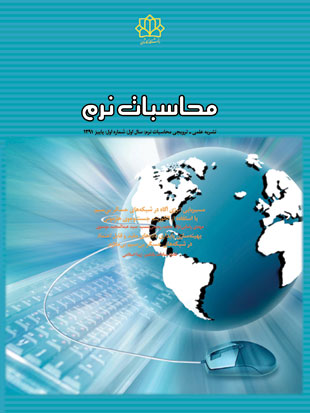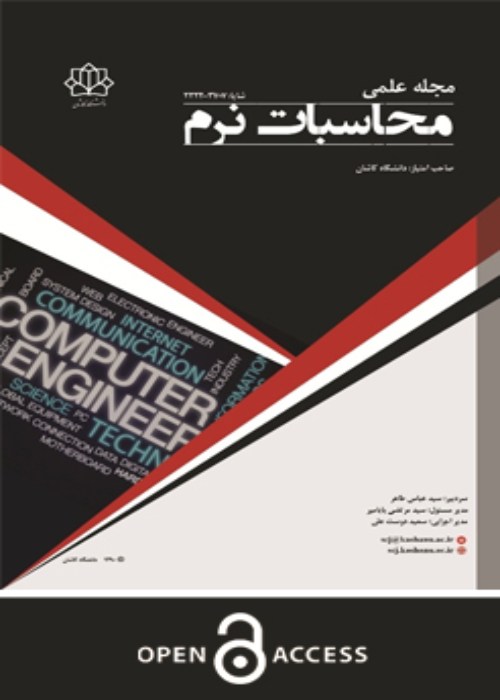فهرست مطالب

نشریه محاسبات نرم
پیاپی 1 (بهار و تابستان 1391)
- تاریخ انتشار: 1391/11/08
- تعداد عناوین: 6
-
-
صفحه 2در حال حاضر، مسیریابی انرژی آگاه، یکی از مهم ترین زمینه های تحقیقاتی در شبکه های حسگر بی سیم محسوب می گردد. افزایش طول عمر شبکه، چالش انگیزترین نیاز در این نوع شبکه هاست. هدف این تحقیق، معرفی الگوریتم جست وجوی هارمونی، به عنوان یک الگوریتم فرااکتشافی موفق برای مسیریابی در شبکه های حسگر بی سیم، در راستای افزایش طول عمر در این نوع شبکه هاست. برای این منظور، در سفارشی کردن این الگوریتم برای مسیریابی، دو معیار کاهش مصرف انرژی و توزیع مناسب مصرف انرژی بین گره های حسگر که منجر به افزایش طول عمر شبکه می شوند، در نظر گرفته شده است. نتایج شبیه سازی ها، توانایی این الگوریتم را در یافتن مسیر بهینه و برقراری توازن مناسب بین دو معیار ذکرشده، به خوبی نشان می دهد. همچنین جهت مقایسه روش پیشنهادی با دیگر روش ها در شرایط کاملا یکسان، یک پیاده سازی با الگوریتم ژنتیک انجام شده است. نتایج مقایسات، ناظر بر عملکرد بهتر الگوریتم جست وجوی هارمونی، نسبت به الگوریتم ژنتیک، در افزایش طول عمر شبکه است.
کلیدواژگان: شبکه های حسگر بی سیم، مسیریابی انرژی آگاه، الگوریتم های فرااکتشافی، الگوریتم جست وجوی هارمونی، الگوریتم ژنتیک -
صفحه 16در شبکه های حسگر بی سیم بی ملازم، داده های جمع آوری شده در گره های شبکه برای مدت نسبتا طولانی ذخیره می شوند تا آنکه گیرنده آن ها را جمع آوری کند. از آنجا که ممکن است یک یا چند گره شبکه به طور اتفاقی خراب شوند و یا آنکه دشمن سیار آنها را تسخیر نماید، چالش اصلی این شبکه ها، نگهداری اطلاعات و ارسال آن به گیرنده به صورت کامل و صحیح است. علاوه بر این باید کارایی ارتباط و حافظه لازم برای دست یابی به این هدف در نظر گرفته شوند. این خصوصیت ویژه، شبکه های حسگر بی سیم بی ملازم را از سایرشبکه های حسگر بی سیم متمایز می نماید. در سال 2011، رن و همکاران طرحی برای بیشینه سازی نگهداری و پایداری داده های جمع آوری شده توسط حسگرهای شبکه، ارائه کردند.دراین مقاله، ابتدا نشان می دهیم که این طرح دارای دو ضعف عمده می باشد: 1- داده منتشر شده در شبکه احراز هویت نمی شود و در نتیجه شبکه را مستعد حمله تزریقی می نماید. 2- داده هایی که در اثر ارسال بین گره ای ناقص شده اند نیز شناسایی نمی شود. این نقاط ضعف موجب افزایش ترافیک و از بین رفتن کارایی شبکه می شود. در ادامه راهکار استفاده از امضای همریخت را برای برطرف کردن این نقاط ضعف، ارائه می دهیم.
کلیدواژگان: شبکه های حسگر بی سیم بی ملازم، دشمن سیار، بیشینه سازی داده، احراز هویت، امضای همریخت -
صفحه 24مسئله برنامه ریزی هفتگی دانشگاه، مسئله پیچیده ای است که حل آن به کمک رایانه، مدت هاست که زمینه فعالیت است. برای حل این مسئله، باید دروس را با توجه به محدودیت های سخت و نرم به زمان ها نسبت داد. محدودیت های سخت باید حتما رعایت شوند (برخی از آن ها تحت شرایطی با هزینه ای بالا قابل نقض اند) و هدف، رعایت هرچه بیشتر محدودیت های نرم است. در این مقاله، کوشش شده با ارائه الگوریتم های جست وجوی محلی مناسب، یک برنامه هفتگی که محدودیت های سخت در آن رعایت شده، بهبود گردد. در واقع، ورودی روش پیشنهادی یک برنامه قابل قبول است که به وسیله یک الگوریتم جست وجوی خاص مسائل ارضای محدودیت به دست آمده است. این ورودی قابل قبول جهت نیل به سمت جواب بهینه به الگوریتم پیشنهادی ارائه می شود. نتایج نشان می دهد که روش پیشنهادی برای داده های واقعی در فضایی با ابعاد بالا و محدودیت های پیچیده، عملکرد بسیار خوبی دارد.
کلیدواژگان: برنامه ریزی هفتگی دانشگاه، جست وجوی محلی، جدول زمان بندی -
صفحه 32در این مقاله مفهوم شکاف دیجیتال و برخی از روش های کمی بررسی آن(نمایه ها) توضیح داده شده است. هر کدام از نمایه های شکاف دیجیتال، تعدادی نشانگر را دربردارند که برای به دست آوردن هر کدام از نشانگرها باید داده های گوناگونی گردآوری شود. به دست آوردن برخی از این داده ها شدنی نیست و برخی نیز به دشواری گردآوری می شود. برای این پژوهش داده های برخی از نشانگرهای شکاف دیجیتال گردآوری شده است که به خوبی وضعیت کشور را در زمینه ی تقسیم فناوری اطلاعات نشان می دهد. سپس بر روی این داده ها خوشه بندی انجام شده است. نتیجه ی خوشه بندی نیز به خوبی نشان دهنده ی وضعیت شکاف دیجیتال در کشور است و تهران در نتیجه ی به دست آمده از خوشه بندی به روش K-means آن چنان تفاوتی با دیگر استان ها دارد که همواره در یک خوشه جداگانه گذاشته می شود.
-
صفحه 46در این مقاله، به بررسی روند توسعه شبکه های عصبی کوانتومی و برخی از مدل های ارائه شده تاکنون و نحوه پیاده سازی فیزیکی این مدل ها پرداخته شده است. نحوه استفاده از آزمایش دو شکاف برای پیاده سازی شبکه های عصبی کوانتومی و روش های طراحی این شبکه ها به همراه نمونه ایی از شبکه های ترکیبی دو لایه که متشکل از نرون های کوانتومی و کلاسیک اند، ارائه شده است. برخی از مدل های کاربردی این شبکه ها در مقایسه با مدل های کلاسیک و قابلیت ها و توانایی های شبک های عصبی کوانتومی، با توجه به مفاهیم موجود در مکانیک کوانتومی در حل مسائلی که برای مدل های کلاسیک بسیار دشوار یا حتی غیر ممکن است، ذکر شده استکلیدواژگان: شبک های عصبی کوانتومی، محاسبات کوانتومی
-
صفحه 56تجهیزات الکترونیکی در کاربردهای فضایی، می توانند مقاوم یا غیرمقاوم در برابر تشعشعات باشند که به دلیل هزینه و عدم دسترسی در بسیاری از کاربردها، گزینه مناسب، استفاده تجهیزات تجاری رایج (غیرمقاوم) است. استفاده از تجهیزات تجاری رایج در کاربردهایی همچون کاربردهای فضایی به خودی خود، قابلیت تحمل پذیری را در برابر تهدیداتی همچون تابش یون های سنگین ندارند؛ لذا باید تمهیداتی را در نظر گرفت که بتوان این تجهیزات را در برابر تهدیدات احتمالی مقاوم کرد. در این مقاله، یک روش مبتنی بر افزونگی نرم افزاری سطح دستورالعمل جهت تشخیص خطاهای روند اجرای برنامه درون و بین بلوکی ارائه شده است که در مقایسه با روش های پیشنهادشده تاکنون دارای سربارهای حافظه کمتر، کارآیی بهتر و پوشش اشکال بیشتری است.
کلیدواژگان: افزونگی نرم افزاری، تجهیزات تجاری رایج، تشخیص خطاهای روند اجرا، کاربردهای فضایی، قابلیت تحمل پذیری
-
Page 2At the present، energy aware routing is one of the most important research topics in wireless sensor networks. Increasing network lifetime is the most challenging need in these networks. In this study، in order to increase network lifetime، we aim to introduce a harmony search algorithm as a successful meta-heuristic algorithm for routing in the wireless sensor networks. In customizing the algorithm for routing، two following criteria، which result in increasing network lifetime، have been considered: reducing energy consumption and proper distribution of energy consumption between sensor nodes. Simulation results clearly showed the ability of this algorithm in finding the optimum route and proper balance between the abovementioned criteria. Moreover، to compare the recommended method with other methods in identical conditions، an implementation of a genetic algorithm has been carried out. Results showed the better performance of harmony search algorithm in increasing network lifetime in compared with genetic algorithmKeywords: Wireless sensor networks, Energy aware routing, Meta, heuristic algorithms, Harmony search algorithm, Genetic algorithm
-
Page 16In wireless sensor networks، the collected data are stored in the network nodes for a long time until the receivers take them. Since some network nodes may become accidentally corrupt or some mobile adversary intrudes to some node، data survival and secure and complete data transmission to some receiver is a concern. Moreover، we should consider communication efficiency and the needed store for the survival. This specific feature distinguishes the unattended wireless sensor networks from others. In 2011، Ren et al. presented a proposal for maximizing survival duration and stability of the collected data by sensor network nodes. In this paper، we first show two main weaknesses of the Ren et al proposal: (1) the propagated data in the network is not authenticated; this weakness causes the network becomes more susceptible to attack and (2) data are not identified when they become corrupt during transmission. These weaknesses cause more traffic in the network and result in the network inefficiency. Having shown the weaknesses، we present a method to resolve them using the homomorphic signature.Keywords: Unattended Wireless Sensor Networks, Mobile Adversary, Data Maximization, Authentication, Isomorphic Sign
-
Page 24University course timetabling problem is a complicated problem and finding a computer-aided solution for it was a subject to work for many years. To solve this problem، we must assign courses to timeslots with respect to hard and soft constraints. Hard constraints are those which must be necessarily met (some of them could be neglected with high costs). Our aim is to meet as many soft constraints as possible. In this paper we present local search algorithms to improve a table which meets hard constraints، and is provided by a searching algorithm for CSPs. Our results show that the proposed method is very suitable for real data with a large size and complex constraints.Keywords: University Weekly schedule, Local Search, Timetable
-
Page 32In this paper، the notion of the digital divide has been described، and a few analyzing methods of digital divide have been reviewed. Analyzing methods of digital divide are called indices which have different indicators and different formulas for calculation. Since data collection for an indicator may be difficult، calculating an index is an essential problem. We collected and calculated some indicators in provinces of Iran. But they were insufficient to calculate a standard index. These indicators terribly show the deep digital divide between the provinces. To show more accurately the social inequalities in the adoption of ICT between provinces in Iran، we used the well-known K-means clustering algorithm on the indicators of the provinces. The clustering results appropriately showed the unique status of Tehran among provinces because Tehran always falls in a different cluster alone. It means that the information technology does not fairly spread through the provinces in Irān.Keywords: Digital Divide, Information Technology, Iran, E, Provision, Clustering
-
Page 46In this paper the development of quantum neural networks (QNN)، and some of presented models and physical implementation are reviewed. How of making use of double-slit experiment for implementing QNN and methods of designing as well as examples of two-layer hybrid networks in QNN constructed from quantum neurons and classical neurons are represented. Some application models of the networks (QNN) is compared with classical models and capabilities of QNN together with the quantum mechanical concepts in solving difficult problems، which is hard to solve by classical models، is noted.Keywords: quantum neural network, quantum computing, two, layer hybrid network, quantum neurons, quantum information processing
-
Page 56Electronic devices in space applications may be Radiation Tolerant or Commercial off-the Shelf (COTS). Due to cost and unavailability in many applications، the latter is usually used. In applications such as spatial ones، the COTS equipment lacks reliability against threats like heavy ion radiation; therefore، some alternatives should be considered to make the equipment resistant against the probable threats. In this paper to checking an Intra-Inter block control flow، a software redundancy method in instruction level is delivered. In comparison with other methods، the proposed method has less memory overhead، better performance and more fault coverage.Keywords: Software Redundancy, Commercial Off, the, shelf Software, Runtime Error Detection, Spatial Application, Fault, tolerance


